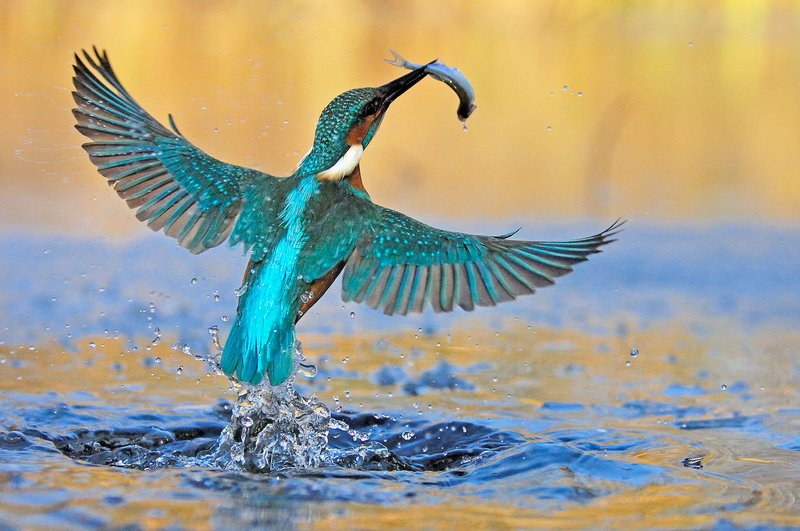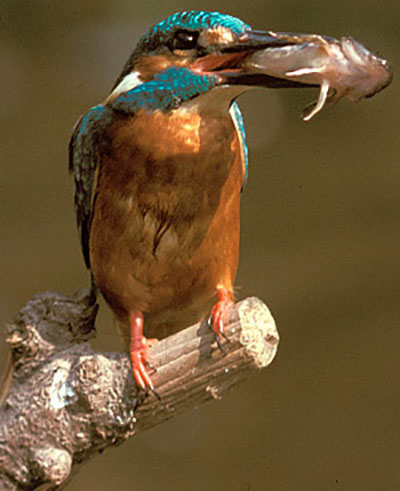The kingfisher (Alcedo atthis) is widespread throughout Europe, but not really common anywhere. As a breeding bird it is to be found all year round in southern, western and central Europe, but in the north and east, it leaves its roosts before winter and migrates to warmer climes. It reoccupies its breeding territories there from the end of January.
The flying jewel
The bird is barely the size of a sparrow, and has almost stunted legs, and an oversized beak. Its plumage makes up for these aesthetic disadvantages, however. The top of its head, its shoulders and the upper parts of its wings are coloured bluish green, with specks of azure blue at the edges, while its dorsal stripe is turquoise. Its rusty red-coloured belly and flanks form a clear contrast to this.
Its dazzling plumage has earned it the name “flying jewel”. The feathers do not contain any blue colour pigments, however. The blue colour can thus disappear in specimens that are subjected to too much stress. The structural colours are due to a special refraction of light on the feathers.
The male and female birds are easy to distinguish from each other. The males have a uniformly dark-coloured beak, whereas the base of the lower beak of the females is reddish. The bird's song and calls are made up of short-syllables, and high-pitched and penetrating.
Successful professional anglers
The habitat of the kingfisher is the natural banks of slow-flowing rivers and streams, as well as stagnant waters. Its diet consists mainly of small fish between four and seven centimetres long, especially small brown trout, gudgeon, minnows, roach, rudd and sticklebacks. In the summer months it also eats insects, tadpoles, snails and crustaceans. The food requirement of the kingfisher, which weighs 40 grams on average, is around 50 per cent of its body weight.
The kingfisher usually hunts from a perch in the riparian vegetation, more rarely by hovering. Once it has spotted a fish, it swoops down on it, diving to a depth of up to one metre. If its perch - for example the lower branches of a tree on the bank - is more than two or three metres from the surface of the water, the kingfisher's hunting success is significantly reduced.
... and industrious civil engineers
Kingfishers are cavity-nesting birds. Pair formation takes place from the end of January / beginning of February. The pair then digs a tunnel up to 90 centimetres long and ending with a brood chamber, in overhanging or vertical steep banks of clay or mouldable sand. The tunnel has a diameter of around nine centimetres. They dig it with their beaks, pushing the debris out behind them with their legs and tail. The brood cavities are used several times, which increases the diameter somewhat.
Suitable broken off edges are at least 50 centimetres high, and free of vegetation and dense roots. They are usually to be found on the cut banks of watercourses, wherever these are still allowed to meander freely and shape the landscape. If necessary, however, the kingfisher will also use gravel pits several hundred metres away from the water, for example.
From mid-April, the female lays six to seven eggs, from which the young hatch after three weeks. The young are usually independent after less than two weeks. The adult birds then start a new brood. They breed up to four times per season, whereby the male can also care for the broods of several females at the same time, if there is enough food available. A large number of offspring is necessary because the mortality rate is 70 to 80 per cent of the cohort. The reason for this is usually a lack of food after harsh winters or floods in spring.
The breeding population in Germany is estimated to be some 5,600 to 8,000 pairs. This is a slightly positive trend in recent years. This is certainly also thanks to more natural hydraulic engineering measures. The low population densities of the kingfisher - usually just one or two breeding pairs are found per ten kilometre stretch of bank (in optimally supplied habitats, a breeding pair can manage with less than one kilometre of river bank in some cases) - indicate the need for further measures.
Flagship species for near-natural water bodies
The [German] Federal Environment Agency now classifies only ten per cent of our waters as near-natural. In most cases structures have been built on the banks; straightening, embankments and sluices inhibit the natural dynamics of the water bodies and make it more difficult for species to migrate upstream. As a result, many characteristic aquatic species, including many of our native fish species, are now under threat.
Wherever the kingfisher still occurs in our landscape, it is a flagship species for near-natural waters with a high quality of water. If this "flying jewel" can colonise an area in high population density all year round, this indicates a high structural diversity.


